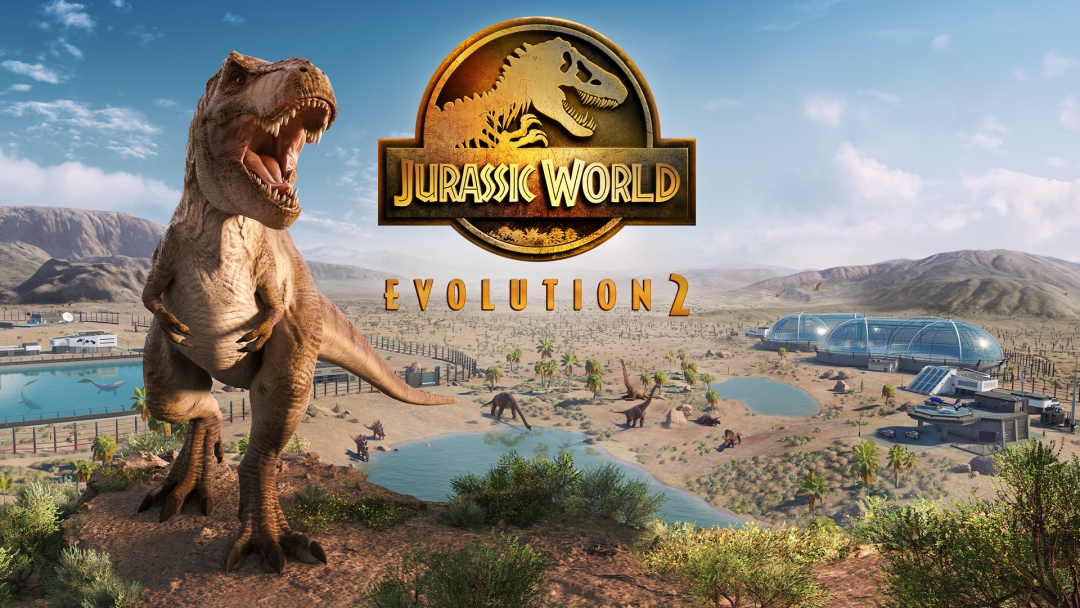
Frontier Developments’ Jurassic World Evolution 2 wasn’t just inevitable as a sequel to a successful game, but also as a licensed tie-in for the upcoming Jurassic World: Dominion movie. I’ve always said that the management sim genre is one of the most logical starting points for a licensed Jurassic Park video game. After all, Jurassic Park: Operation Genesis from 2003 is still considered a bit of a cult classic among fans.
Considering their success with Planet Coaster and Planet Zoo; Frontier Developments is perhaps best suited to create a great theme park management sim, based on the beloved franchise. Sadly, the results have been pretty mixed so far.
While I did manage to find quite a bit of enjoyment in 2018’s Jurassic World Evolution, it was held back by fairly simplistic mechanics, rudimentary AI, and a lot of bugs. Still, it garnered enough of a fanbase that a sequel was certain.
Despite my mixed feelings about the first game, I was pretty excited to see how Jurassic World Evolution 2 turned out. Previews and trailers all looked promising, with the addition of aquatic and flying animals, more complex dinosaur AI, and a variety of tweaks to management and core features.
While Frontier Developments definitely made a fair number of positive changes to the formula of the first game, Jurassic World Evolution 2 still has a lot of room for improvement.
Jurassic World Evolution 2
Publisher: Frontier Developments
Developer: Frontier Developments
Platform: Windows PC (reviewed), PlayStation 4, PlayStation 5, Xbox One, Xbox Series X|S
Release Date: November 9th, 2021
Players: 1
Price: $59.99
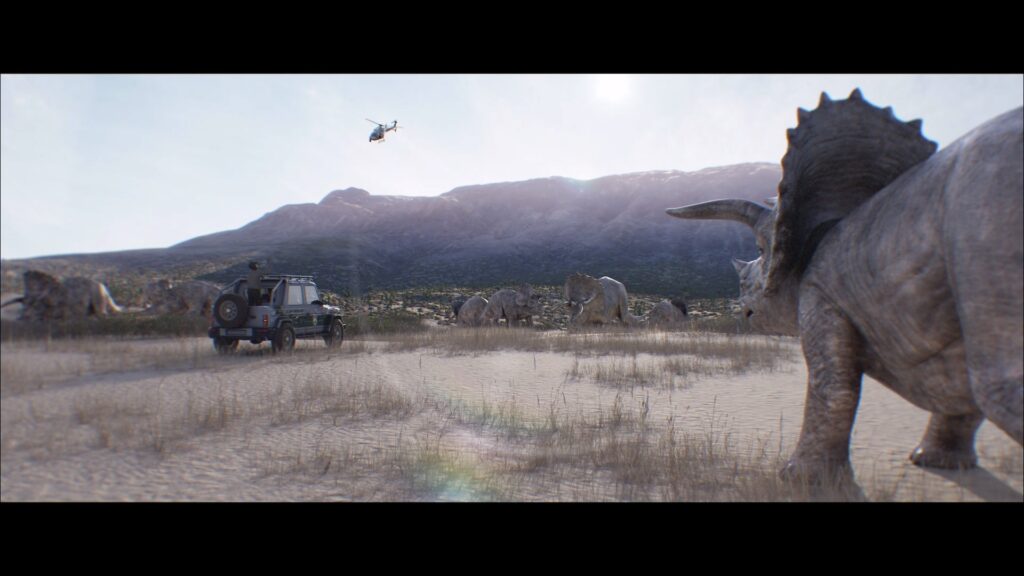
Jurassic World Evolution 2‘s campaign acts as both a sequel to the previous game; as well as a prequel to the upcoming Jurassic World: Dominion movie.
Following the extremely dumb and contrived events of Jurassic World: Fallen Kingdom, dinosaurs are now rampaging their way across the globe. Large herds of herbivores have taken over many national parks, and carnivorous dinosaurs turning humans into tasty snacks is now an everyday fear for many people living in rural areas.
Owen and Claire now work with the Department of Fish and Wildlife Services, as part of a special task force that responds to calls related to dinosaurs. Their primary job is to track, capture, and relocate problem animals. Several other characters from the previous game and movies appear as well, including Ian Malcom and Dr. Wu.
As with Jurassic World Evolution, only Jeff Goldblum actually does any voice acting for his in-game character, with the rest being played by actors doing pretty bad impersonations of Chris Pratt and Bryce Howard.
Not that Jeff Goldblum really adds much to the game; his performance sounds pretty phoned in like the first game. The character of Ian Malcom has basically been distilled to “that crazy old boomer that always rambles about chaos.”
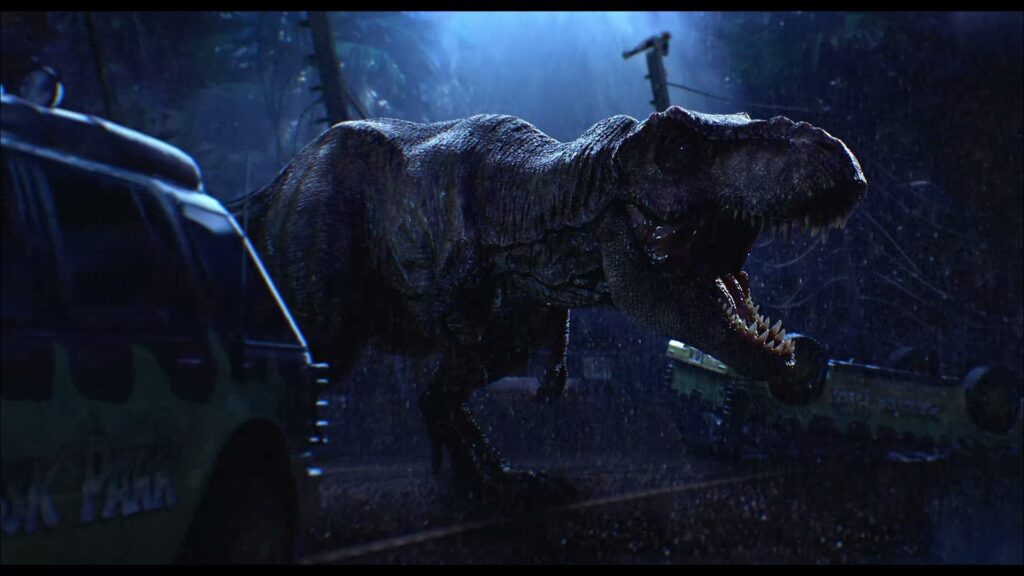
The campaign is really short, and will probably only take you around three hours to complete. In theory it acts as an extended tutorial, but in practice it’s not even adequate at that. Many core mechanics aren’t even mentioned during it. The campaign honestly feels rushed and thrown in to tie the movies together because some exec from Universal Studios said it had to be there.
It also ends with a cliffhanger that hints at some animals being transferred to secret facilities for unknown reasons. So, I assume Jurassic World: Dominion is going to go with the whole military-trying-to-weaponize-dinosaurs-plot for the third time in a row.
Luckily, a short and mediocre campaign aren’t why you are playing Jurassic World Evolution 2. The real meat of the game consists of the various challenge scenarios, sandbox playgrounds, and the new Chaos Theory mode.
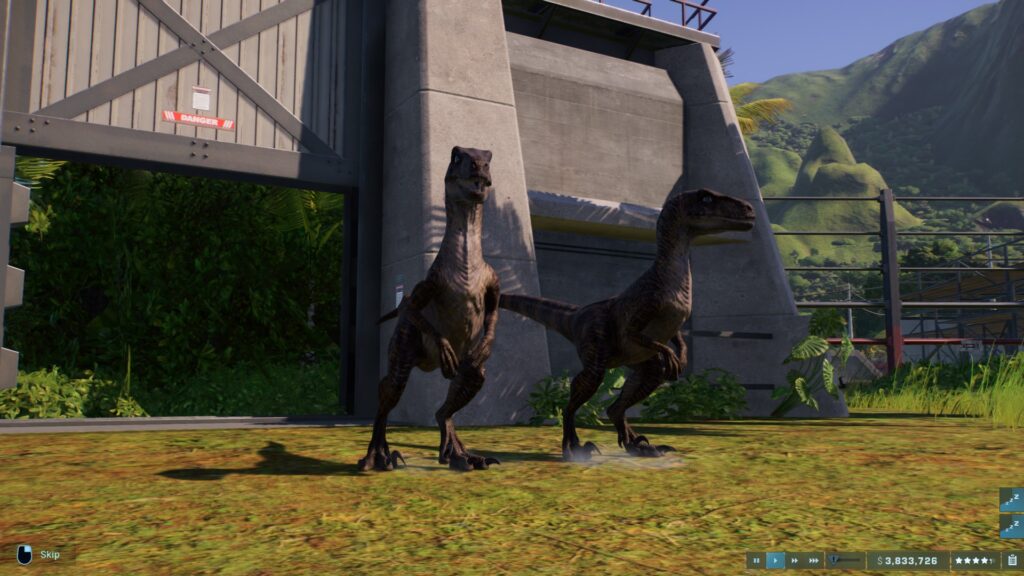
Chaos Theory consists of five “what if” scenarios, loosely based on Jurassic Park history. They include missions like placing you in control of the original Jurassic Park, or trying to finish the incomplete Jurassic Park San Deigo facility from the second movie. A few of them delve into the gaps between films; like Masrani Corp’s operation to capture dinosaurs from Site B for the construction of Jurassic World.
The Chaos Theory missions vary in complexity, difficulty, and overall goals. Many of them are pseudo tutorials that delve into park management concepts not brought up in the lackluster campaign.
They’ll often gate off certain pieces of content until you fulfill specific goals, and generally start off a bit hand-holdy. Later on, you’re allowed you to pursue your mission objectives with a higher degree of freedom.
The Challenge maps are more open-ended, and are meant to really test your skills managing a dinosaur theme park. This mode has difficulty settings that determine how frequent or devastating random or scripted events can be, with the overall goal being to reach a 5-star park rating.
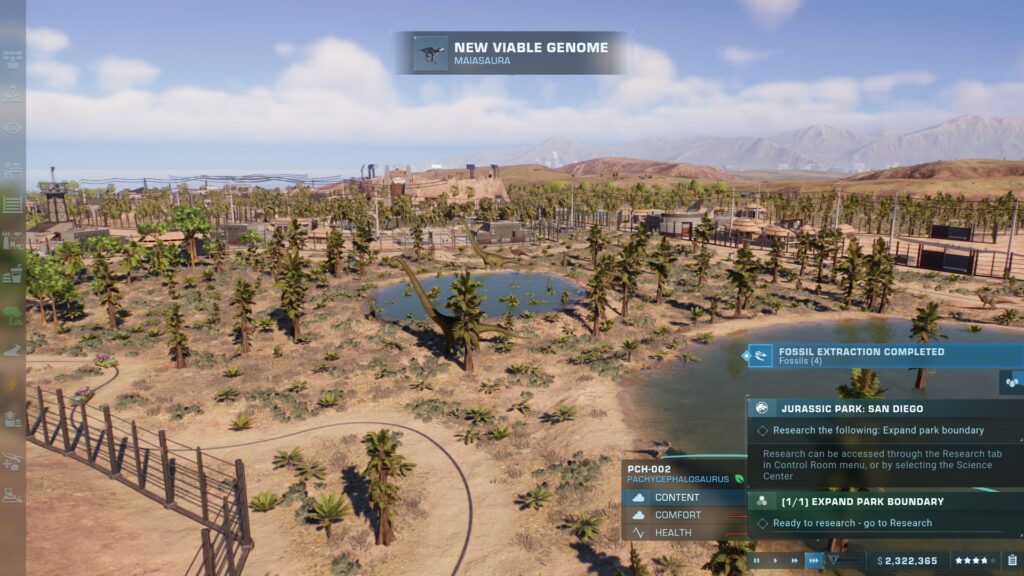
Regardless of which mode you choose, most of your time spent in Jurassic World Evolution 2 will be devoted to creating a profitable dinosaur theme park by balancing the needs of your guests and animals.
Many of the core mechanics that govern the construction and management of your theme park are largely unchanged from the original. You’ll start with an arrival point for your guests, and an operations center. From there you get to go wild designing, building, and stocking your park with genetically engineered theme park monsters.
As far as guests are concerned, they’ll need a few key things. Hotels, viewing platforms to see your dinosaurs, rides like gyrospheres or park tours, restrooms, amenities to spend their hard-earned money at, and emergency shelters to escape storms and rampaging dinosaurs.
Guest management is a bit simple, but not as finicky as it sometimes was in the original game. Your guests are relatively easy to please, and generally just want restrooms and at least one restaurant, gift shop, and drink stand at regular intervals as they walk around the park.
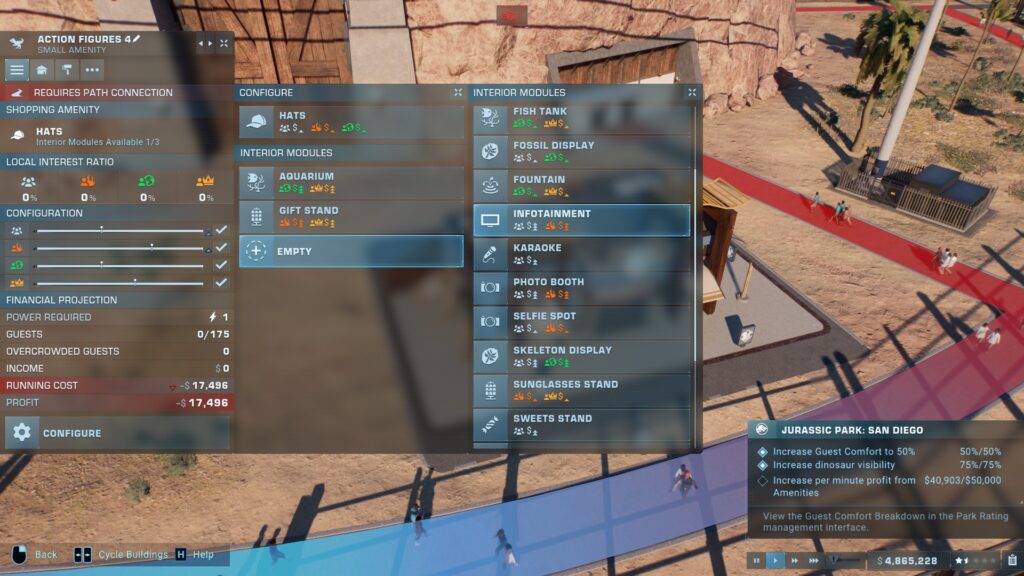
Each amenity can be customized with modules that cater to specific types of guests. These guest types can generally be described as your standard normie visitors, eco tourists and animal enthusiasts, thrill seekers, and wealthy tourists with a lot of money to throw around.
Each type of attraction and dinosaur tends to draw in specific types of guests. So, if you find your amenity sales dipping, you can tweak the modules you have installed to cater to the needs of the guests hanging out in different areas of the park.
Dinosaur management, on the other hand, is a fair bit more complex this time around. It still mostly revolves around constructing paddocks, raising dinosaurs from hatcheries, and tweaking each enclosure to meet the needs of the dinosaurs you plan to populate it with. There are a lot of nice improvements and added details in Jurassic World Evolution 2.
For one thing, herbivores no longer need feeders that you have to manually resupply all the time. Instead, there is a variety of vegetation that you can scatter around the enclosure that the herbivores will graze from. Herbivore diets can be broken down to leaves, fiber, fruits, and nuts. All you need to do is get the right balance of plants that produce the correct food in your enclosure for the dinosaurs inside it.
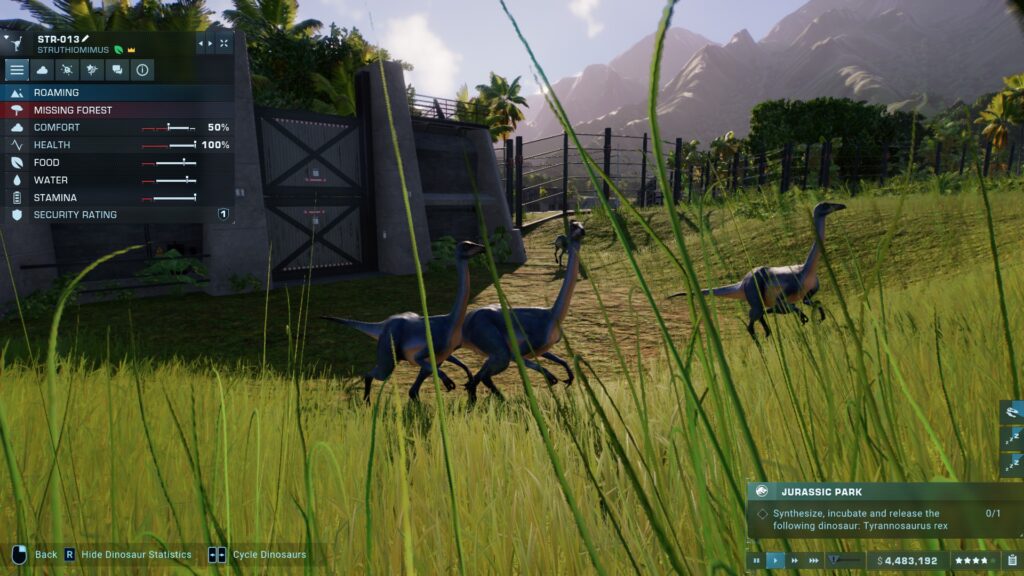
Each dinosaur also has a list of species they can happily coexist with. These habitation preferences weren’t as clearly defined in the original game. Now they are directly spelled out for you to make large, multi-species enclosures a lot easier to create.
Dinosaur AI is also a lot more complex and realistic. Dinosaur comfort levels aren’t as finicky as they previously were. Unlike the first game, I haven’t seen nearly as many cases of dinosaurs getting mad over the number of trees being 1% below their optimum preferences and try to break out.
Socializing and pack hunting are now more complicated and fleshed out as well. In the original game, pack hunters like raptors still just fought other species in one-on-one duels. Now they will all pile in and try to overwhelm larger opponents. Fights are more dynamic, with better animation quality. The range of attacks an animal might utilize also expands depending on their various combat stats.
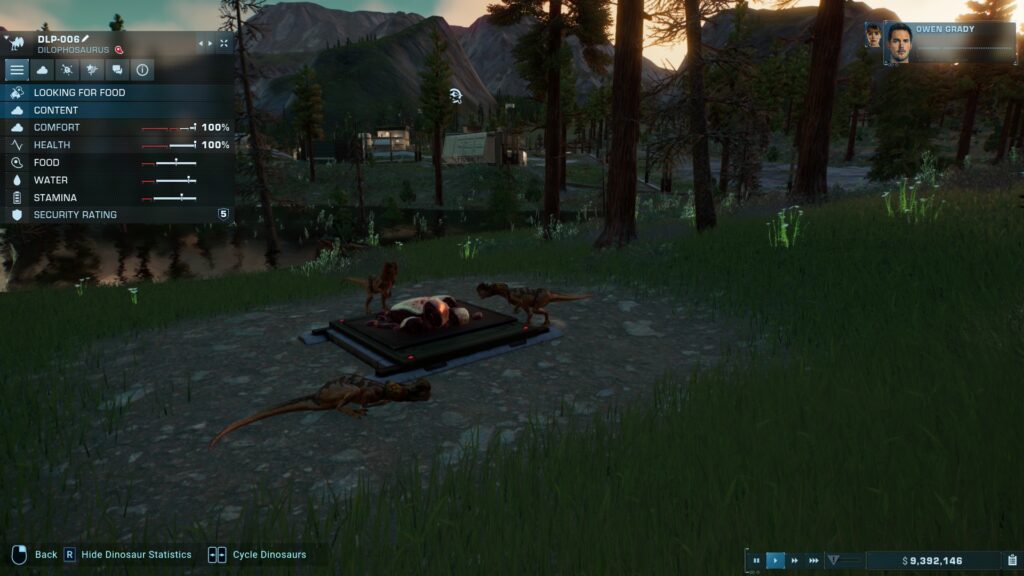
Alphas and battles for dominance are yet another mechanic made deeper in the sequel, though it’s not really explained well in-game. In one level, my raptors kept getting into fights despite having 100% comfort. After a little digging, I learned that this is because the alpha was viewed as weak by the rest of the pack, which led to fights over dominance.
This means that with certain species, you’ll want to tweak their genetics to boost their stats and combat prowess. If a clearly stronger dinosaur is the alpha, then there will be less fights over dominance among the pack.
While dinosaur AI is largely improved across the board, there is one area where its seriously messed up: flying animals. Jurassic World Evolution 2 adds aviaries and lagoons, two highly requested features that expand the diversity of prehistoric animals you can have in your park. Unfortunately, aviaries are currently pretty much broken.
Your flying reptiles have so many bugs and AI quirks, that it’s probably not even worth adding any to your park. Flying animals are currently only programmed to perch on specific things; like the viewing platforms you install for guests to watch them. If they can’t find a perch, they will literally fly around until they die of exhaustion. Worse, sometimes they’ll just bug out and fly in place forever.
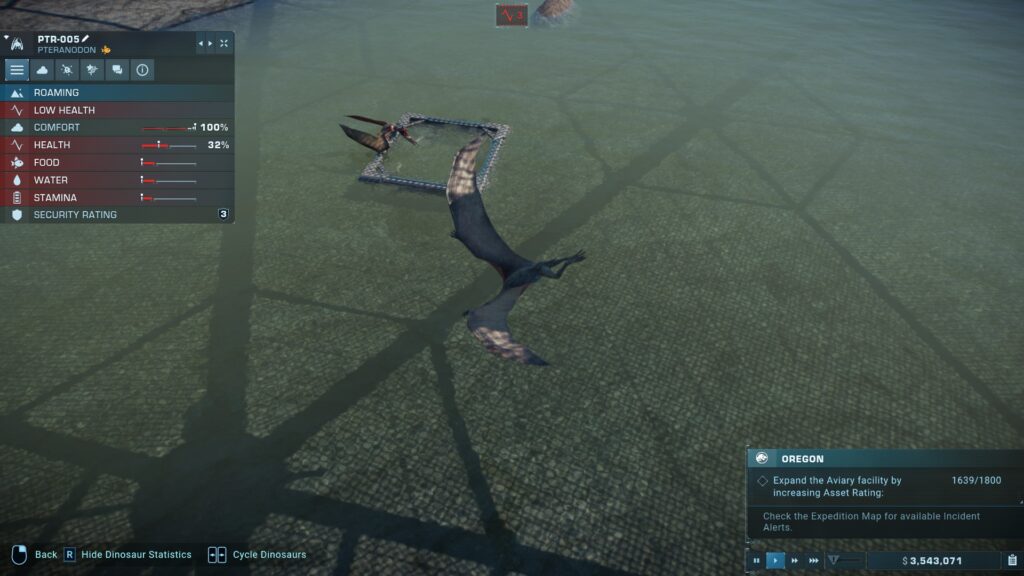
This can sometimes be fixed by sending a capture team into the aviary to tranquilize them and reset their AI. Unfortunately, the nature of the aviaries means that your capture teams must enter the aviary hatchery and deploy drones to get to your flying reptiles.
These also like to bug out, resulting in the drones flying around aimlessly inside the aviary, instead of doing their assigned task. Thankfully, Frontier Developments have announced they will be allowing flying animals to perch on rocks, along with resolving other issues.
While such bugs are mostly regulated to the flying animals, they still appear from time to time elsewhere. Occasionally dinosaurs will glitch out and need to be “reset” by tranquilizing them. I also encountered several instances of dinosaurs clipping through fences to escape or attack guests.
Oh, and the game has some hilariously awful ragdoll physics sometimes. This is most noticeable when driving jeeps around on anything that isn’t a completely flat surface, and when transporting sauropods and other really large dinosaurs.
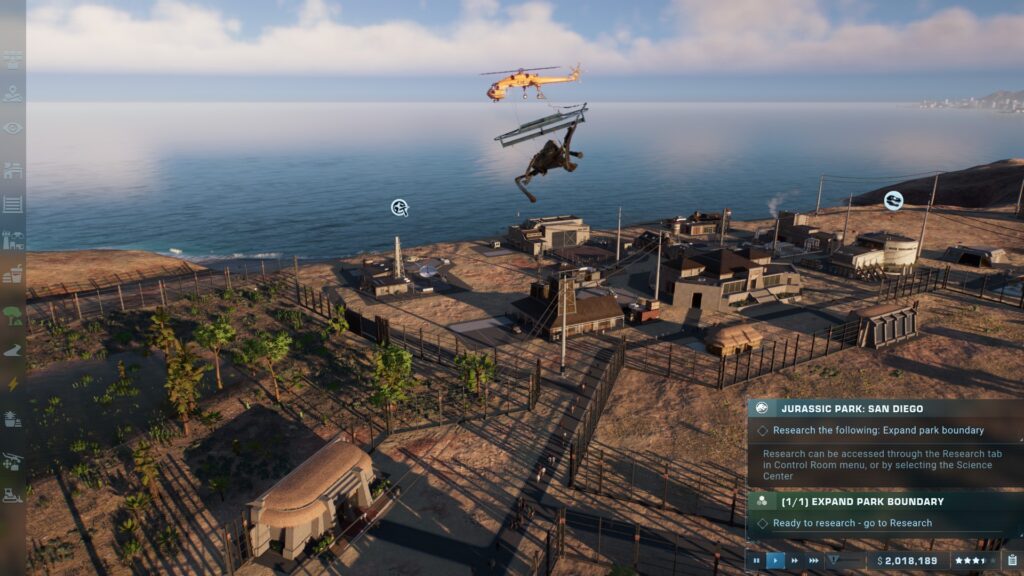
Caring for your dinosaurs is largely the same as the original game. You’ll need to construct response facilities throughout your park, acting as a base for your ranger and capture teams.
Rangers can be assigned to posts that they will patrol, checking on the status of all dinosaurs in the area and resupplying any feeders. Capture teams operate from helicopters and are used to tranquilize dinosaurs that either escaped their enclosure, or must be sedated for treatment.
Speaking of treatment, Jurassic World Evolution 2 has added a new type of maintenance staff; Mobile Veterinary Units that operate from your paleo-medical facilities. When a dinosaur gets injured, you’ll need to dispatch an MVU to diagnose what’s wrong.
MVUs can administer medication and treat light injuries in the field. More complicated problems will require an animal to be sedated and transferred to your paleo-medical facilities.
While rangers, capture teams, and MVUs do most of the field work, your scientists manage the backend. Each scientist is a character with their own bio, stats, and perks. Whenever you need to research a new technology, treat an injured dinosaur, send someone to a dig site, extract DNA from fossils, or raise new dinosaurs for your park, you’ll be assigning your scientists to the task.
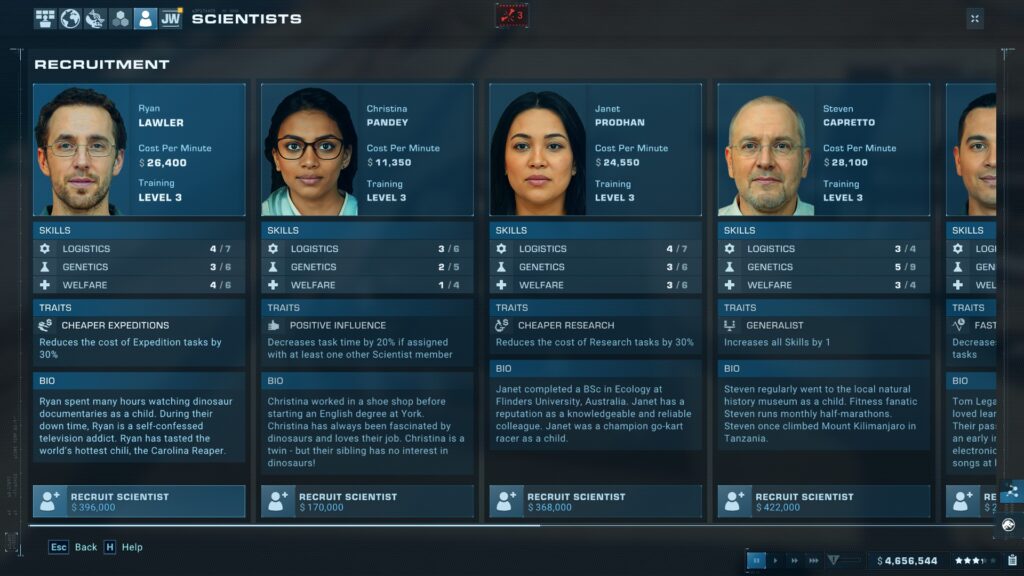
Each scientist has three core stats- Logistics, Medical, and Genetics- determining how suitable they are for specific tasks. Sometimes you’ll need to use multiple scientists for more complicated tasks.
Each scientist also comes with a perk; like working for a lower salary, working faster when assigned specific tasks, or boosting the stats of scientists they are paired to work with. The core stats of your scientists can be further enhanced with training, though every stat has a hard cap that varies from scientist to scientist.
Regardless of the tasks you assign, every job scientists perform generates stress. When they get too stressed out, they’ll become disgruntled, which reduces their efficiency. If you continue to push scientists, they’ll eventually begin sabotaging your operations in various ways.
Yes, they brought back the universally reviled sabotage mechanic from the first game. Luckily, sabotages are pretty easy to avoid by just giving your overworked scientists a vacation every now and then.
Many changes to management and dinosaur AI are welcome additions. Unfortunately, they also introduce a lot of tedious and unfun micromanagement tasks, adding nothing to the experience beyond busywork. It’s great that you no longer have to manually resupply feeders anymore, but this was replaced with manually refueling your response and paleo-medical facilities.
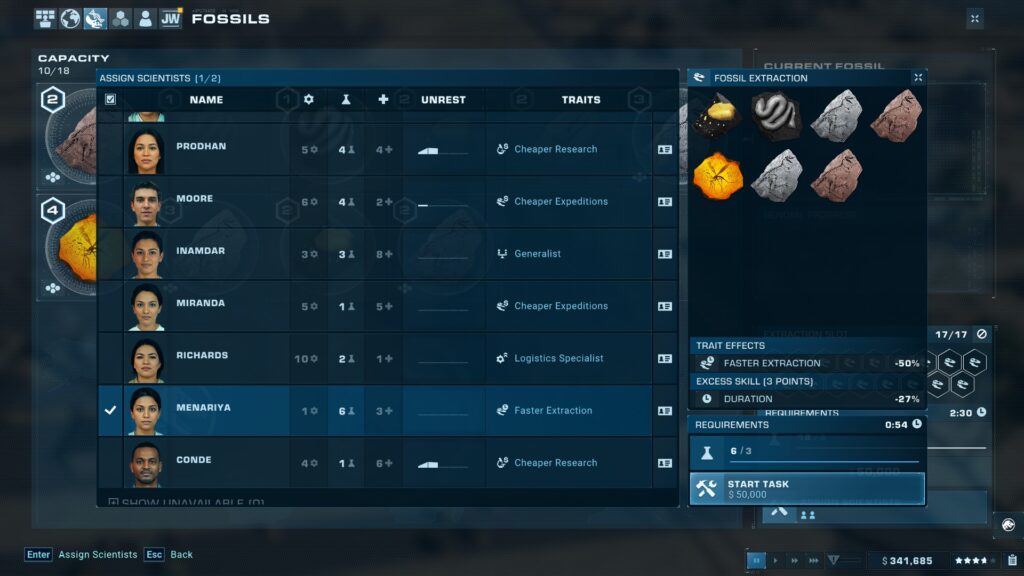
You also no longer have unlimited access to up-to-date information on every dinosaur anymore. Your rangers have to be assigned to posts that they will patrol, then manually scan every dinosaur in range of the post. After a set amount of time, the status check expires.
This wouldn’t be so annoying if it wasn’t for the fact that rangers can sometimes get stuck on terrain, or otherwise have trouble figuring out the pathway to their assigned task. They’ll get there eventually, but their pathfinding certainly leaves much to be desired at times.
The MVU is another nice change, but more complex injuries are far too frequent and tedious. Being alerted to an injury is irritating. It means you have to send out an MVU to scan the dinosaur, then manually tell them to treat it if it’s a simple injury or a disease you have medicine for. Apparently, they’re too stupid to do that on their own.
If it’s something that requires the use of your paleo-medical lab then you’ll then need to send out a capture team to tranquilize the dinosaur, then a transport to bring it to the hospital, assign a scientist to treat it, and then transport it back to their enclosure.
It doesn’t help that injuries just happen way too often, and frequently with no clear cause. It makes sense if the dinosaur got into a fight, but I’ve experienced plenty of situations where a dinosaur just suddenly gets a concussion or major organ trauma for seemingly no reason.
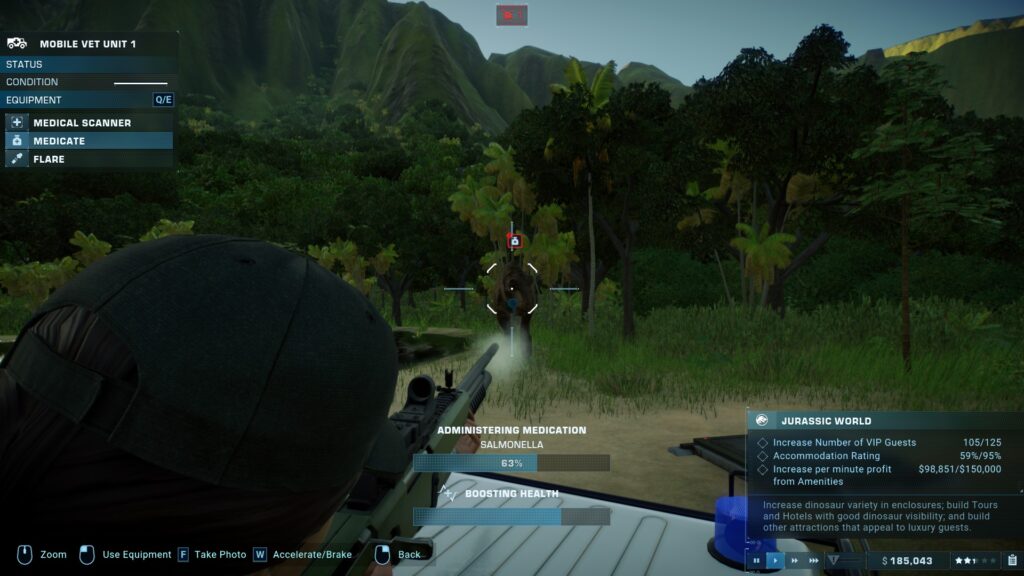
In one instance, a Gallimimus in a paddock I was working on improving received an injury. Upon scanning it, I learned it was a concussion. I saw the dinosaur the entire time- it was just walking around doing nothing and got a concussion.
It turns out that scientists were wrong about all their theories. It wasn’t a meteor, or the Ice Age, or some plague that killed off the dinosaurs. It was that dinosaurs just spontaneously got concussions or broken bones during the mere act of walking around and existing.
The epitome of tedious busywork and micromanagement in Jurassic World Evolution 2 are the storms. In the first game, storms were usually an annoyance that you have to spend a few minutes dealing with every now and then. In Jurassic World Evolution 2, storms can be absolutely devastating.
There are times when a storm comes along and decides to do its best Vin Diesel impression, performing high speed donuts and drifts through your park as if it’s a sentient being purposefully targeting every single building and enclosure you have. It’s possible for a single tornado to bring financial ruin to a park you spent hours creating, destroying the fences of nine of your ten enclosures, and severely damaging 87% of the buildings.
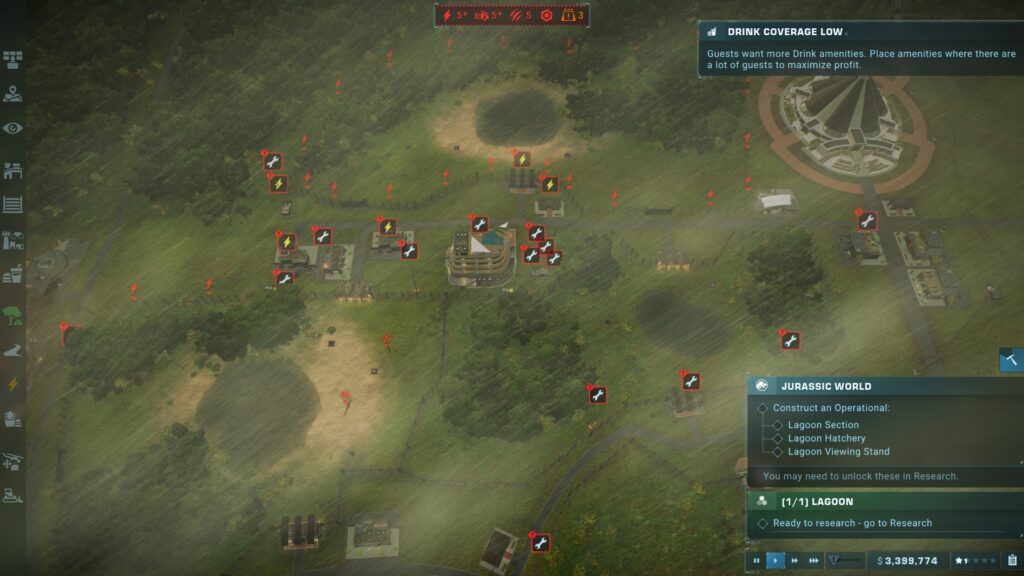
Now dinosaurs are everywhere, and you don’t have the money to fix everything required just to get the park running at a basic level again. I have had storms that were so devastating I wasn’t done fixing the damage when another one came along. At which point, you just scrap everything and restart the scenario.
Part of the overpowered nature of storms has to do with the changes to storm protection. In the original game, this was handled by storm defense structures that granted a degree of resistance to nearby buildings.
Now it’s a module you have to install on each building, taking up a precious slot that could be used by something more desirable. This system also does nothing to protect your fences. In my experience, a lot of the time tornadoes just laugh at your storm defense modules and destroy everything anyway.
Luckily, many of these annoying micromanagement issues will be addressed in an upcoming patch that tones down storms, along with the frequency of fights, diseases, and injuries. For now though, they are a major irritation that can seriously impact your enjoyment of the game.
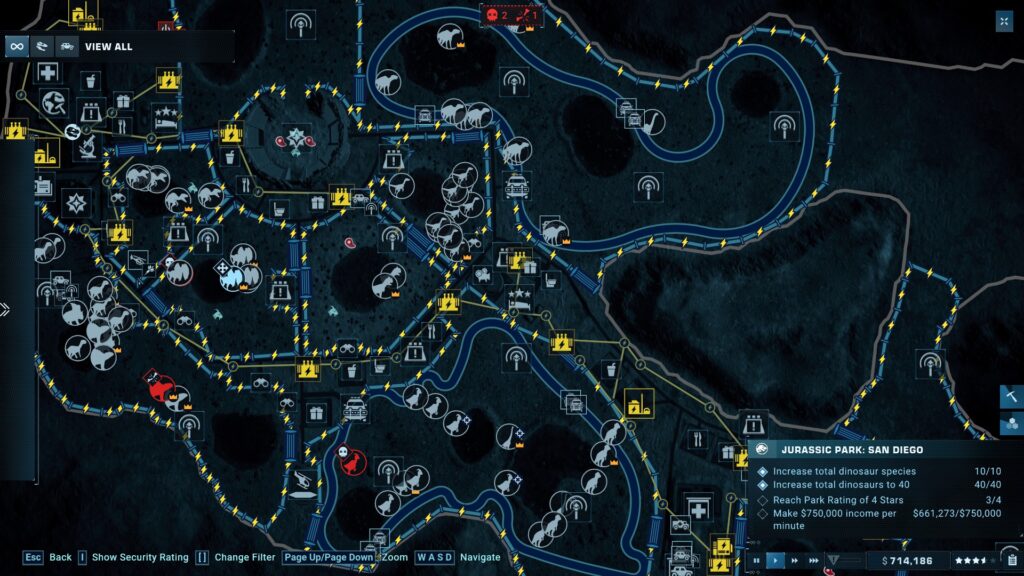
My final big complaint is that Jurassic World Evolution 2 still lacks a proper sandbox mode. This was one of the main complaints a lot of people expressed with the first game, and Frontier Developments have sadly failed to address it.
Much like in the original, Jurassic World Evolution 2‘s sandbox mode requires you to unlock everything through the other modes. This can easily take you upwards of 50 hours or more to do, depending on how many times you need to restart scenarios due to the overpowered storms.
Even when everything is unlocked, the sandbox mode is still so limited. There aren’t nearly enough options you can tweak to customize your experience. Worse, the game suffers from the same map size problems of the original, with even the largest maps feeling too confined for the sheer number of species you can clone.
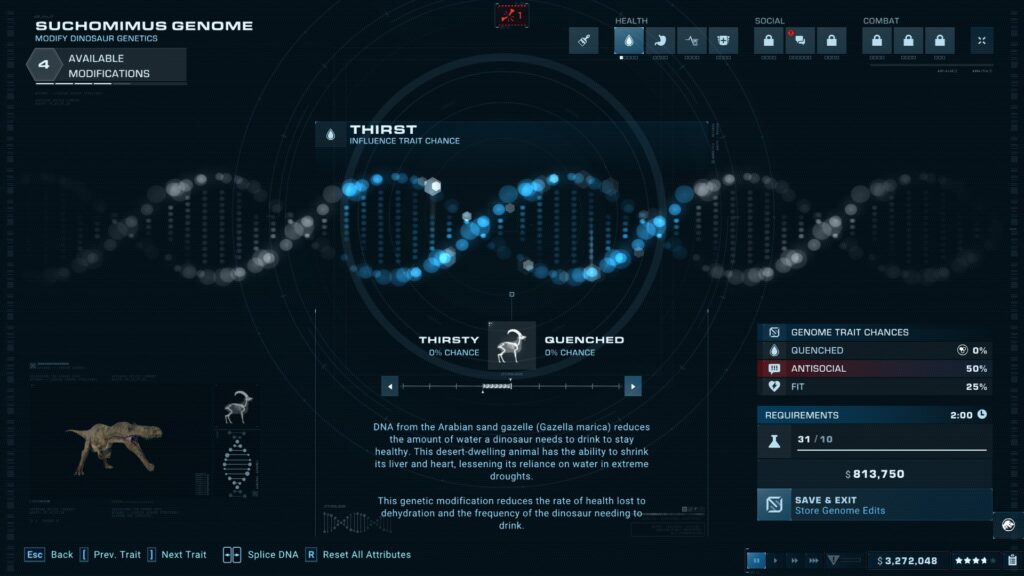
Jurassic World Evolution 2 is a game I have extremely mixed feelings about. As someone who enjoys dinosaurs, Jurassic Park, and management sims, it’s easy to find yourself drawn into a trance while playing. Hours can disappear in an instant as you design enclosures, set up the tracks for your safari tours, and extract DNA from fossils to unlock more dinosaurs to populate your park with.
One of the things Jurassic World Evolution really nailed was having a huge variety of highly detailed dinosaurs that all looked, sounded, acted, and moved just like their counterparts from the films.
In this regard, Jurassic World Evolution 2 is a complete success, and adds even more variety with the addition of aviaries and lagoons. The original (as well as Planet Zoo) have tons of animal packs, so I’m sure the overwhelming number of dinosaurs you can show off in your park will only expand in the coming months.
At the same time, Jurassic World Evolution 2 has quite the long list of issues to overcome. As aforementioned, Frontier Developments have announced they will fix the issues with storms, fights, injuries, and flying animals.
This will certainly help address many of my complaints about the game. Some issues however, like all the tedious micromanagement, limited sandbox options, and various AI bugs and glitches, will remain. The aviary in particular needs a lot of work considering how buggy the flying animals are.
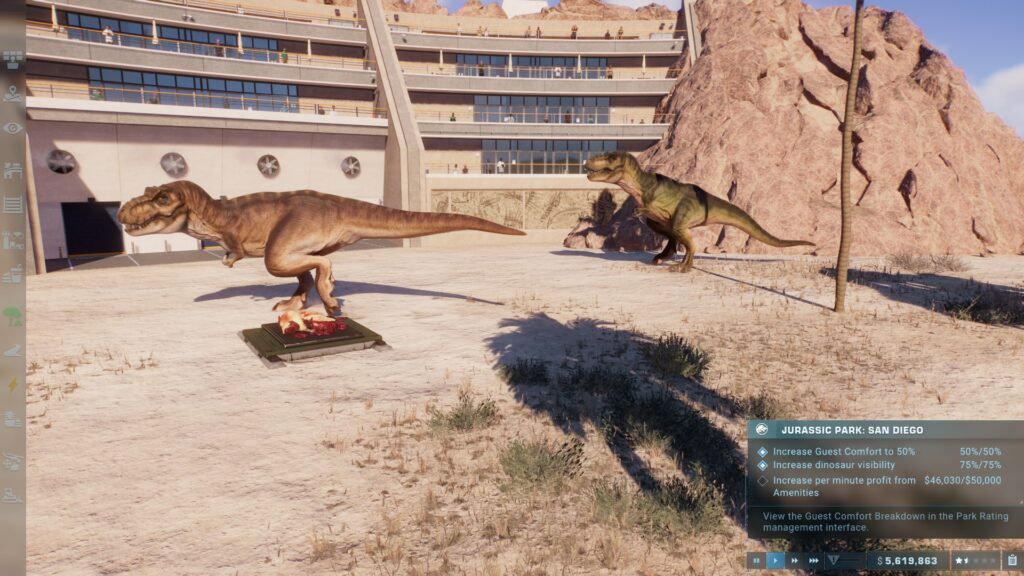
While my complaints are numerous, I still enjoyed Jurassic World Evolution 2 more than I was frustrated by it. It’s already better than the original in many ways, and with a few more patches and DLC, it will probably be a great theme park management game. For now, I’d personally recommend holding off to see how the game is improved in the coming months.
Jurassic World Evolution 2 was reviewed on Windows PC using a copy provided by Frontier Developments. You can find additional information about Niche Gamer’s review/ethics policy here.